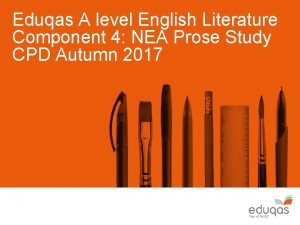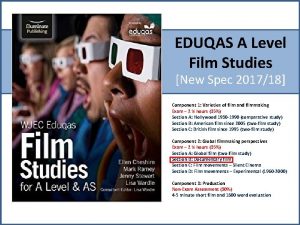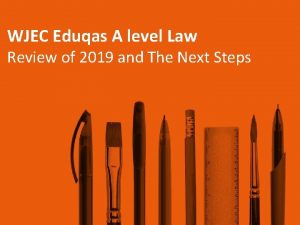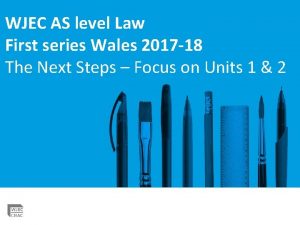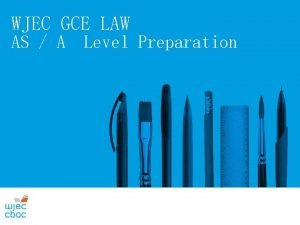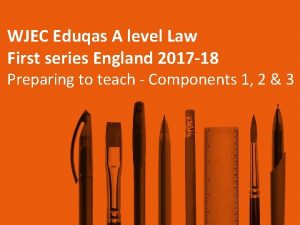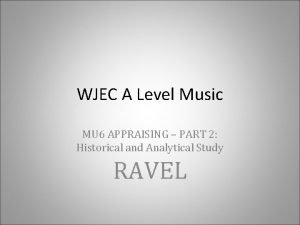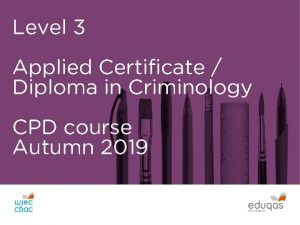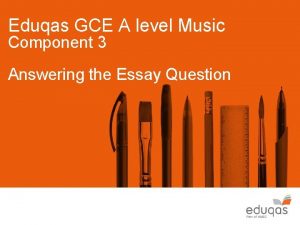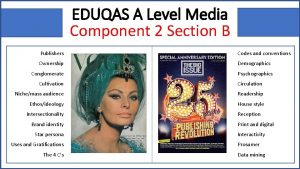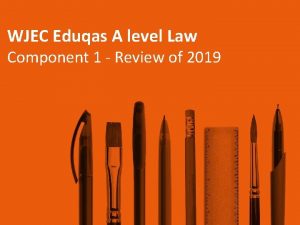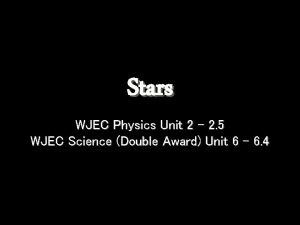WJEC Eduqas A level Law Review of 2019


























- Slides: 26

WJEC Eduqas A level Law Review of 2019 and The Next Steps

COMPONENT 3: Perspectives of Substantive Law As in Component 2 there are 4 subject areas available. Section A - Law of contract (private law) B - Law of tort (private law) C - Criminal law (public law) D - Human rights law (public law) The areas covered in C 2, for each section must also be covered for C 3 and candidates should be prepared for a 45 minute evaluative essay on any aspect. 2

COMPONENT 3: Perspectives of Substantive Law Each section has a choice of 2 essay questions from which one must be selected. All are out of 25 marks. Assessment objective break down AO 1 - 10 marks AO 3 - 15 marks AO 1 – Demonstrate knowledge and understanding of legal rules and principles (Explain) AO 3 – Analyse and evaluate legal rules and principles (Analyse and Evaluate) 3

COMPONENT 3: Perspectives of Substantive Law • The essay section is the one that often serves to differentiate between candidates. • Given the wide range of potential questions, candidates should ensure they know how to construct essay answers in general and then they are equipped to deal with what appears in the exam question. • High scoring essays will contain well supported lines of debate – which may include recent news stories, examples and legal authority. 4

COMPONENT 3: Perspectives of Substantive Law • Answers need to be clearly structured with an introduction focused on the specifics of the question and a conclusion that sums up the arguments. • Candidates should practice writing introductions and conclusions to essay questions. • There should be a focus on the actual question and its wording and not just the area of law generally. • Key words from the question itself should be constantly referred to e. g. fair, consistent, in need of reform, fit for purpose etc. 5

COMPONENT 3: Perspectives of Substantive Law Section A - The Law of Contract Question 1 - Analyse and evaluate whether the law on discharge of contracts should be reformed. ● This was the least popular of the 2 questions but one of the highest scoring on the whole paper. ● The best answers methodically considered the 4 ways in which a contract may be discharged, namely agreement, performance, frustration and breach. ● Stronger answers also included specialist terminology including impossibility, illegality and commercial sterility. 6

COMPONENT 3: Perspectives of Substantive Law ● Better answers provided an obvious attempt at addressing theme of the question and used the words that appeared in it. ● Many good answers placed an emphasis on whether areas needed reforming. ● Weaker answers omitted one or more of the four ways to discharge a contract or failed to provide the detail expected. ● Many answers considered AO 3 at the end of the explanation of the law on all four ways of discharge. This method had a tendency to repeat the law prior to considering reform. Whilst not wrong it impacted upon time and produced a less accomplished answer. ● There was a tendency to include other areas of contract law e. g. misrepresentation for which no credit was awarded. 7

COMPONENT 3: Perspectives of Substantive Law Question 2 - The rules for communication of offer and acceptance have developed with changes in society; however some areas of the law are still unclear. Discuss. ● The most popular of the 2 contract questions and often well answered. ● Many answers focused on changes in society especially in regards to communicating an offer and acceptance. ● Some responses felt the law was adequate and others indicated the opposite view. Both would receive credit provided the answer explained reasoning. 8

COMPONENT 3: Perspectives of Substantive Law ● The more sophisticated answers considered instantaneous methods of communication and the lack of case law and firm rules to determine the existence of the elements of offer and acceptance. ● Reference to telex, email and links to modern methods of communication in the business world was also included. ● Problems of identifying offers from invitation to treat. ● Answers that merely stated rules and hinted that they were confusing, without explanation, did not access the upper marks bands, especially for AO 3. ● There were many cases available to include. ● Some answers also included other essential elements of a contract, other than offer and acceptance. ● Where consideration and privity of contract were also included it was considered irrelevant to the mark scheme. 9

COMPONENT 3: Perspectives of Substantive Law Section B - The Law of Tort Question 1 - The Occupier’s Liability Acts of 1957 and 1984 are a great improvement on existing laws, but attention is still needed to ensure that the law is fit for purpose. Discuss. ● This was the most popular question on the paper. ● Many answers showed a clear understanding of occupier’s liability and the differences between the 1957 and 1984 Acts. ● Candidates who accessed band 4 were using a range of case citations and accurately stating the sections of the relevant Acts. 10

COMPONENT 3: Perspectives of Substantive Law ● Weaker candidates put together a range of evaluative points but they did not go further than one or two sentences with a superficial consideration of the issues involved. ● Often these were not in any particular order and were not linked to case law or citations from the Act. ● There should be a focus on the question with use of keywords, rather than giving pros and cons. ● Candidates were formulating their own answer and not reciting model answers provided for them in revision. ● A small minority of candidates confused the law on occupier’s liability with a negligence question. 11

COMPONENT 3: Perspectives of Substantive Law Question 2 - Analyse and evaluate the extent to which the defences of consent and contributory negligence are fair and effective. ● Both defences were expected to be considered from a civil perspective. ● Key words in the question should regularly appear. ● Depth of evaluation on this question was generally superficial and did not expand upon why the points raised were fair or not. ● Only the best candidates used legal authority and unfortunately, most candidates did not include any authority. ● Most candidates focused mainly on the fairness aspect and avoided the effectiveness discussion. 12

COMPONENT 3: Perspectives of Substantive Law ● A significant number of candidates answered this question about the criminal defence of consent. ● Ensure that candidates appreciate the difference between similar concepts in the individual options. ● Many common sense answers with little law. ● Contributory negligence aspect usually produced either detailed answers or a few sentences. ● Depth of evaluation on this question was generally superficial and did not expand upon why the points raised were fair or not. ● Only the best candidates used legal authority and unfortunately, most candidates did not include any authority. 13

COMPONENT 3: Perspectives of Substantive Law Section C - Criminal law Question 1 - To what extent does the law relating to bail place too much emphasis upon protecting the public and not enough emphasis on the presumption of innocence. ● The most popular question on the criminal law option. ● Stronger responses, elicited some impressive, evaluative answers on the balancing of conflicting issues in relation to bail. ● Again it was important to focus on theme of the question and use key terms. ● Both police and court bail should appear. At times answers confused the two areas. 14

COMPONENT 3: Perspectives of Substantive Law • It was good to see frequent reference to the Hookway decision and the 28 day limit on police bail in the Policing and Crime Act 2017. • Rarely did the response by the police to what has been termed ‘release under investigation’ (RUI) appear. • Weak answers failed to include legislation or cases. • The Bail Act 1976 often varied in its year. PACE appeared but rarely in its full title. • Little mention of Legal Aid, Sentencing and Punishment of Offenders Act 2012 (LASPO) (associated persons test & no realistic prospect), Criminal Justice and Public Order Act 1994 (conditions), Criminal Justice Act 2003 (street bail) or Policing and Crime Act 2017 (28 days). 15

COMPONENT 3: Perspectives of Substantive Law Question 2 - How far have the courts been willing to go in recognising the defences of duress and necessity? ● Answers seemed to fall into one of two categories, either very good or very weak. ● Need to consider both defences. Duress was the better known one. However at times only ‘by threats’ appeared. ● Points were stated as relating to both defences with no differentiation between the two. ● Many did write about the unavailability for murder, and attempted murder, and were able to link this back to the question. 16

COMPONENT 3: Perspectives of Substantive Law ● Some answers only focused on this and limited detail of duress by threats. ● They are not partial defences as some scripts suggested. ● Other defences such as insanity, automatism and intoxication appeared in answers. No credit was given for this. ● There was some excellent knowledge shown of the development of necessity ranging from cases such as Dudley and Stephens (1884), Re F (Mental Patient: Sterilisation) (1990) to Re A (Conjoined twins) 2000. 17

COMPONENT 3: Perspectives of Substantive Law Section D - Human Rights law Question 1 - To what extent, if at all, does the law relating to obscenity amount to an unjustifiable restriction upon the right to freedom of expression? ● This was the least popular of the two human rights law questions and generally produced the weaker of the answers. ● There were many common sense answers that did not really address the legal issues rather just suggested that freedom of expression was an important human right. 18

COMPONENT 3: Perspectives of Substantive Law ● As usual the better responses included case law such as R v Penguin Books, Shaw v DPP and Knuller v DPP. ● Few answers explained the development of this area of law or related it back to the question, commenting on the unjustifiable restriction. 19

COMPONENT 3: Perspectives of Substantive Law Question 2 -The Human Rights Act 1998 is proving to be an effective substitute for a Bill of Rights. Discuss. ● A popular choice with some excellent evaluative answers. ● Historical development of human rights law in the UK and the incorporation of Convention rights into the Human Rights Act in 1998 was credited. ● Strong answers went on to consider the provisions of the HRA, e. g. S 2, S 3, S 4, S 6, S 7, S 10, S 19, which they used to evaluate their effectiveness. 20

COMPONENT 3: Perspectives of Substantive Law ● It did not matter whether an answer preferred the HRA or a bill of rights as long as reasoning was present providing the required evaluation. ● Therefore answering the question from the perspective of a bill of rights was similarly creditworthy. ● It was difficult to get into top mark bands without an evaluation of the criticisms of the provisions of the Human Rights Act 21

Next steps Development for next year ● There is a need for answers to be more skills based. ● Answers providing only knowledge will produce restricted marks. ● There is a need to teach students how to produce an evaluative answer for any topic. It is not likely to come naturally to them. ● Teach the skill of analysis and evaluation and then students can use it to address any question. ● Anything on C 2 could also be on C 3. This provides a wide range of potential questions and you will not be able to cover them all in class. ● Equip students with the knowledge and skill of being able to address any topic that appears. ● Constantly link the answer back to the question. Use key terminology. 22

Next steps ● Support points with legislative authority, accurately cite them, including a year for a statute. ● Cases very much support answers and allow higher mark bands to be achieved. ● Do not produce all the facts of cases but rather extract the important legal point and show that relates to theme of the question. ● If a student learns a ‘model answer’ make sure they can deviate from it to address the actual question. ● Make them aware of potential key terminology to evaluate - Fit for purpose, fair, efficient, balance, produce justice, reform, how satisfactory, unclear, certainty etc. 23

Next steps A suggested essay plan Introduction ● A summary of what the essay will say, the key points. ● Include an appropriate word/phrase from the question. Main body Make a point, be eloquent, use of sophisticated language, clear and detailed. Include legislation. Authority in support, case law, example, judicial or other authoritative opinion/ link to question. Counter argument, supported by authority or example. Link to question. Repeat……. Conclusion A summary of what you have said in the main body. Produce an overall judgement and a summary argument. Relate to the question using the key terminology. 24

Next steps A suggested essay plan Introduction ● A summary of what the essay will say, the key points. AO 1 ● Include word/phrase from the question. AO 1 AO 3 Main body Make a point, be eloquent, use of sophisticated language, clear and detailed. Include legislation. AO 1 Authority in support, case law, example judicial or other authoritative opinion/ link to question. AO 3 Counter argument, supported by authority or example. Link to question. AO 1 AO 3 Repeat……. Conclusion A summary of what you have said in the main body. Produce an overall judgement and a summary argument. Relate to the question using the key terminology. AO 1 AO 3 25

EXTRA RESOURCES 1. 4. Guidance for Teaching 2. Online Resources 3. ITEM LEVEL DATA You can access this via the Secure Website – your Exams Officer will give you access. 26
 Eduqas english literature past papers
Eduqas english literature past papers Wjec eduqas a level english literature
Wjec eduqas a level english literature Wjec eduqas film studies for a level & as
Wjec eduqas film studies for a level & as Eduqas product design a level
Eduqas product design a level Eduqas english language a level
Eduqas english language a level Eduqas english language component 1 past papers
Eduqas english language component 1 past papers Wjec english literature specification
Wjec english literature specification Wjec a level law
Wjec a level law Eduqas a level law
Eduqas a level law Wjec law a level
Wjec law a level Wjec past papers law
Wjec past papers law A level law eduqas
A level law eduqas Wjec criminology unit 3
Wjec criminology unit 3 Wjec gce english literature
Wjec gce english literature English literature a level wjec
English literature a level wjec Eduqas a level english language
Eduqas a level english language Wjec a level music
Wjec a level music Gareth hughes criminology
Gareth hughes criminology Wjec walled garden
Wjec walled garden Wjec hospitality and catering
Wjec hospitality and catering Explain how dishes on a menu address environmental issues
Explain how dishes on a menu address environmental issues Wjec a level geology
Wjec a level geology Wjec epq
Wjec epq Eduqas online exam review
Eduqas online exam review Eduqas a level english literature past papers
Eduqas a level english literature past papers A level music eduqas
A level music eduqas Eduqas a level media
Eduqas a level media

